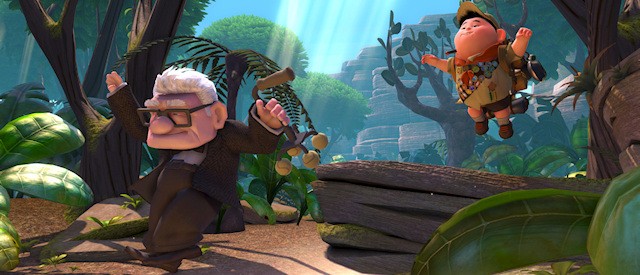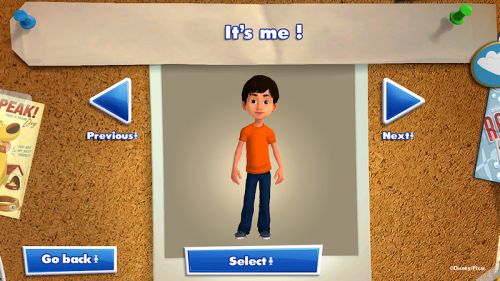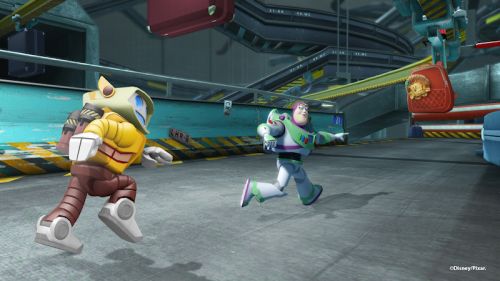

In the last six months, a whopping three games that combine multiple Disney properties have come to consoles: Disney Universe, Kinect Disneyland Adventures (hereafter called KDA), and now Kinect Rush: A Disney-Pixar Adventure (the latter two obviously being Xbox 360 exclusives). Somehow I’ve ended up reviewing all of them – I guess having a young kid skews one’s interests a bit. Kinect Rush stands out as the first all-Pixar game, celebrating several of the Disney CG studio’s most popular films (while omitting a few). Developer Asobo Studio, producer of the excellent Toy Story 3 along with Up, Ratatouille, and Wall-E videogame adaptations certainly has the Pixar know-how that such a project requires.
In the awkwardly-named Kinect Rush (seriously, nobody could think of a better title?), players take on the role of kids attending a Pixar-themed summer camp. The camp features levels based around five Pixar properties: Toy Story, Rattata, I mean, Ratatouille, Up, The Incredibles, and Cars.

Before you get to camp, you’ll need to create a character. The Kinect scans your body and uses it to produce a Pixar-looking child avatar. Mine didn't resemble me too greatly outside of color choices, but it’s a nice idea. The character creator absolutely couldn’t scan my daughter correctly no matter how still she stood (presumably due to her small height), but you can always select from a few pre-made characters if necessary. Every time you select your character (custom or preset), the game runs through a montage of how the character will look in the different minigames: a superhero, car, rat, scout, and toy robot. The montage should really be skippable since it lasts for several seconds and never changes.
After selecting your character and save file, the game asks if anyone else would like to play. Unfortunately, the process for signing in a second player is the worst I’ve seen in a Kinect title. It asks the second person to step into the playing field, but in my experience the game doesn’t usually want to recognize player two while player one is still around – not that it says anything about the first player stepping away. Once player two has created a character and player one comes back, it’s then a short struggle to get the first player recognized and in control again. Frustrating players right off the bat isn’t usually the best way to start a game, but things do get better.
Kinect Rush’s hub world resembles a large park, with five playground-ish areas devoted to specific Pixar films. It’s populated by non-interactive kids who all look the same (other than hairstyles and skin and clothing colors). You can walk up to each movie’s area and initiate the corresponding minigames, but that’s it. Since the hub world doesn’t serve any purpose besides establishing atmosphere, the time-saving option to select each game from a menu (as KDA offered) would have been nice.

"That porcupine's stealing our luggage!"
I mentioned that each movie has its own minigames, but levels would be a more accurate term. See, both the hub world and all of the movie levels (other than Cars) use the same method of navigation. Making a running motion with your arms moves forward and turning your shoulders turns the character. I like that it’s consistent between levels, but this is the third movement scheme I’ve had to learn in a non-linear Kinect game – KDA and Haunt use totally different systems. There’s something to be said for consistency in control methods instead of reinventing the wheel all the time. The fact that you have to move your arms constantly to propel the character forward can be tiring – I much prefer simply holding my arms up a bit as with the previous Disney game. Turning is also kind of slow, 180 degree turns proving most inconvenient. I did get used to all of this after a few games, but the learning curve can be off-putting.
The non-driving levels are basically 3D platformers. You’ll run, jump swing from ropes, and more as you team up with NPCs and act out scenarios from each movie. In Up, the player and Russell get to chase after Carl’s house, escape from Muntz’s zeppelin, and more. The Incredibles has you teaming up with Violet to avoid nasty hazards, rescue Mystique, and battle a spider-like Omnidroid. Toy Story involves helping Woody rescue the porcupine toy nobody cares about from Al (the guy in the chicken suit from Toy Story 2); and you’ll rescue a rat in jar and paddle through a sewer in Ratachooga (admittedly this is only film I haven’t seen yet).
Cars, as you might expect, is purely driving. It controls just like Kinect Joyride, players twisting their arms as if holding a steering wheel. Because of the naturalistic control scheme, the Cars levels are the easiest to get into. I loved zipping around as a secret agent car, jumping over pits and through signs as I raced to stop a bomb from going off.
The fact that Kinect Rush’s levels aren’t just minigames is its greatest strength. Instead of just doing movie-ish things like in KDA, it really feels like you’re in the movies. Their atmosphere is perfectly captured with beautiful graphics, spot-on sound (mostly using the real movie voice actors), and great level design. Because there are only three levels per film, none of them wears out its welcome – you can have a blast even if you don’t care about the rat movie or Larry the Cable Guy pretending to be a mentally-handicapped truck instead of a mentally-handicapped comedian.
Each level has a fair bit of replay value, too. The points you earn from collecting coins and completion time at the end of the level fill up a reward meter for that level. You’ll unlock secondary objectives (such as trapping Muntz’s dogs in Up), new moves, and new helper characters from the films. These open up different areas ala Metroid and increase scoring potential, so you can finally achieve Gold and Platinum medals. Each level also hides four hidden collectibles that unlock the ability to play as characters from the films.
Even if you didn’t sign in a second player at the beginning, another person can drop in or out at any time (yes, we’re finally getting back to the co-op now). Kinect Rush has one big advantage over KDA and that’s split-screen play. While the hub world does not lend itself to exploration, the actual levels contain alternate paths and loads of coins that you couldn’t grab all by your lonesome. In fact, one player can stay behind looking for things while the other runs on ahead – you’re not tethered together. That’s usually cool, but sometimes my partner struggled with a particular bit and I wished that the game would just warp them to me like a lot of other titles do.
Speaking of helping each other, most levels in Rush have one or more simple co-op puzzles. These tend to involve one player stepping on a switch so that the other can reach a new area or unlock a new path. They mostly enhance the co-op experience, but if one person isn’t adept at the motion controls (they’re tricky, remember), it can get frustrating. On the plus side, fail at a puzzle too many times and you’re given the option to skip ahead of it together.
A few more co-op notes: while progress is only saved to one player’s save file, both players earn Achievements. Oddly, Rush only has friends leaderboards rather than global ones, much like a Windows Phone game. If none of your friends play the game, the lists will just be empty. But there are at least separate co-op leaderboards; a good idea since scoring potential is much higher in co-op games.
It takes a while to start really enjoying Kinect Rush: A Disney-Pixar Adventure thanks to the challenging motion controls. But those controls do allow for some really interesting and fun level designs, which is where Asobo shows their expertise. Rush really captured the most exciting moments from each movie. The co-op is a step up over KDA since both players get to move around independently and interact in meaningful ways. It’s just a shame that co-op is locked behind the usual tedious Kinect sign-in process, made worse here by confusing menus. Get past those Kinect foibles and you'll have a great time pretending to be in these family-favorite movies.